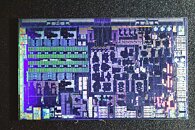- Joined
- Oct 9, 2007
- Messages
- 46,439 (7.66/day)
- Location
- Hyderabad, India
| System Name | RBMK-1000 |
|---|---|
| Processor | AMD Ryzen 7 5700G |
| Motherboard | ASUS ROG Strix B450-E Gaming |
| Cooling | DeepCool Gammax L240 V2 |
| Memory | 2x 8GB G.Skill Sniper X |
| Video Card(s) | Palit GeForce RTX 2080 SUPER GameRock |
| Storage | Western Digital Black NVMe 512GB |
| Display(s) | BenQ 1440p 60 Hz 27-inch |
| Case | Corsair Carbide 100R |
| Audio Device(s) | ASUS SupremeFX S1220A |
| Power Supply | Cooler Master MWE Gold 650W |
| Mouse | ASUS ROG Strix Impact |
| Keyboard | Gamdias Hermes E2 |
| Software | Windows 11 Pro |
The 4 nm "Phoenix 2" monolithic APU silicon powering the lower end of AMD's Ryzen 7040-series mobile processors, could very well be the company's first hybrid core processor, even though the company doesn't advertise it as such. We first caught whiff of "Phoenix 2" back in July, when it was described as being a physically smaller chip than the regular "Phoenix." It was known to have just 6 CPU cores, and a smaller iGPU with 4 RDNA3 compute units; in comparison to the 8 CPU cores and 12 compute units of the "Phoenix" silicon. At the time a lack of 2 CPU cores and 8 CUs were known to be behind the significant reduction in die size from 178 mm² to 137 mm², but it turns out that there's a lot more to "Phoenix 2."
A die shot of "Phoenix 2" emerged on Chinese social media platform QQ, which reveals two distinct kinds of CPU cores. There are six cores in all, but two of them appear larger than the other four. The obvious inference here, is that the larger cores are "Zen 4," and the smaller ones are the compacted "Zen 4c." The "Zen 4c" core has the same core machinery as "Zen 4," albeit it is re-arranged to favor lower area on the die. The trade-off here is that the "Zen 4c" core operates at lower voltages and lower clock-speeds than the regular "Zen 4" cores. At the same clock speeds, both kinds of cores have an identical IPC. The two also have an identical ISA, so any software threads migrating between the cores will not encounter runtime errors. Unlike Intel Thread Director, AMD can use a less sophisticated software-based solution to ensure that the right kind of workload is allocated to the right kind of cores, and prevent undesirable migration between the two kinds of cores. Unlike the hardware-based Thread Director, AMD's solution can be continually updated.

View at TechPowerUp Main Site | Source
A die shot of "Phoenix 2" emerged on Chinese social media platform QQ, which reveals two distinct kinds of CPU cores. There are six cores in all, but two of them appear larger than the other four. The obvious inference here, is that the larger cores are "Zen 4," and the smaller ones are the compacted "Zen 4c." The "Zen 4c" core has the same core machinery as "Zen 4," albeit it is re-arranged to favor lower area on the die. The trade-off here is that the "Zen 4c" core operates at lower voltages and lower clock-speeds than the regular "Zen 4" cores. At the same clock speeds, both kinds of cores have an identical IPC. The two also have an identical ISA, so any software threads migrating between the cores will not encounter runtime errors. Unlike Intel Thread Director, AMD can use a less sophisticated software-based solution to ensure that the right kind of workload is allocated to the right kind of cores, and prevent undesirable migration between the two kinds of cores. Unlike the hardware-based Thread Director, AMD's solution can be continually updated.

View at TechPowerUp Main Site | Source









